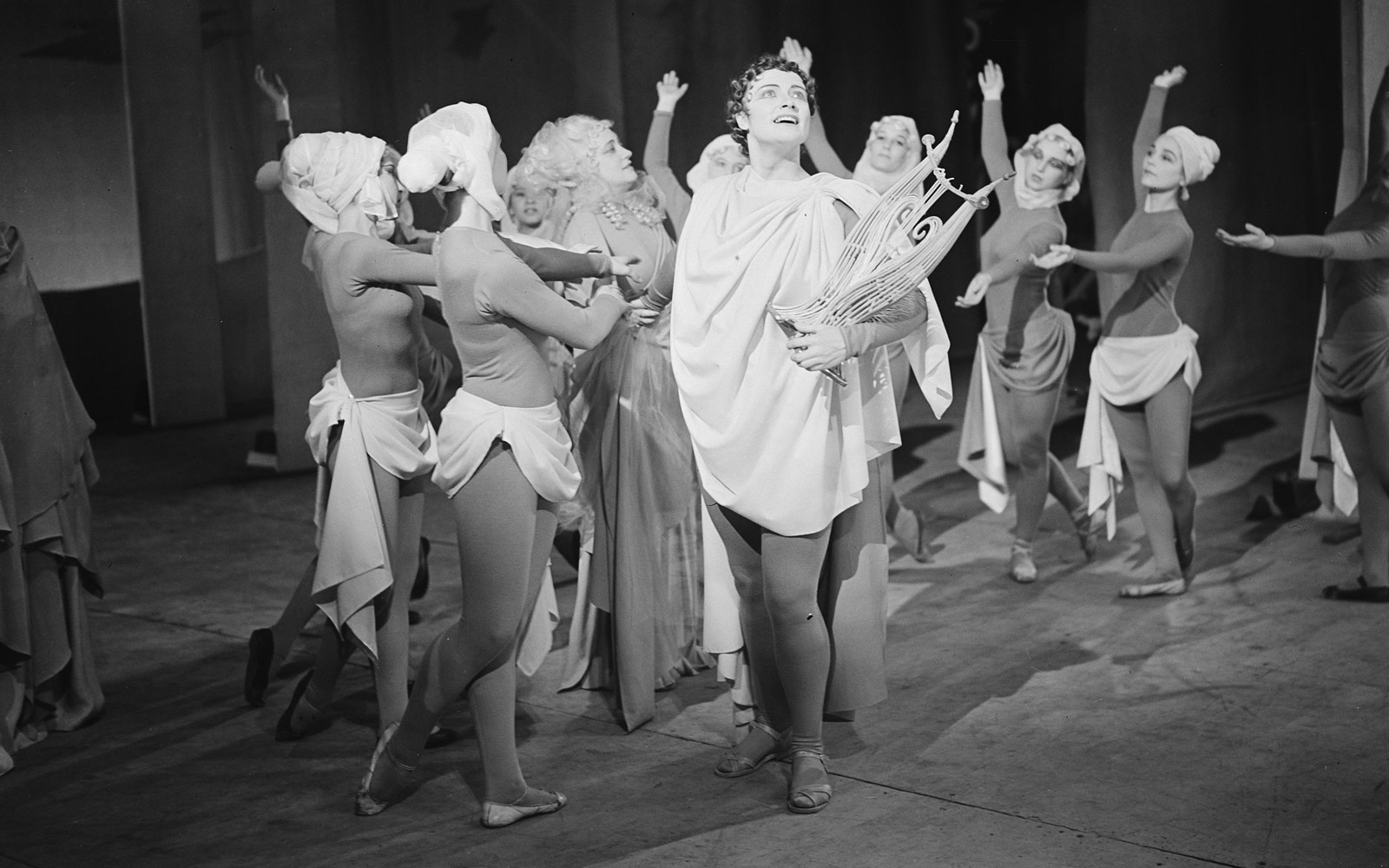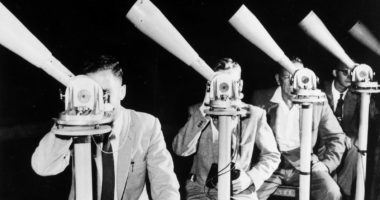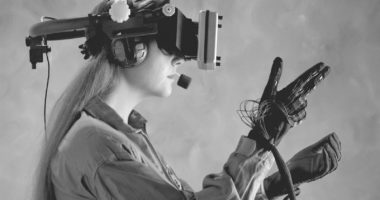
Orfeo ed Euridice, 1949 | Nationaal Archief | Public Domain
Björk’s capacity for experimental intuition is infinite and possibly this is the reason why she has found such a fruitful creative ally in digital innovation. At a time when the audiovisual is experiencing a creative boom in technological innovation similar to that of the early days of cinema, those artists with the most open and lively minds are appropriating these new languages to transform their practice, in this case musical, towards a broader body of work, that increasingly places the spectator at the centre of the experience – from “storytelling” to “storyliving”.
The Björk Digital exhibition is a selection of immersive video clips for her latest album Vulnicura, which the Icelandic artist has been producing since she released the album in early 2015. It is, therefore, an immersive album, but above all, an unapologetic celebration of the starring role that the new immersive audiovisual is taking on in culture. At the exhibition, visitors will pass through different rooms where they can view video clips of the artist via three different audiovisual devices: multi-channel screens, 360º immersive video and virtual reality video.
With each of the works, spectators will be able to identify moments in which this new format clearly contributes a unique and different approach at the audiovisual. We see this in Stonemilker (the first of the works, which dates from 2015) exploring the space in 360º while we follow the artist as she physically splits into two and three. And very especially in NotGet, where Björk makes an emotional journey transforming her body before us into a visual show. This can be experienced just couple of inches away from the artist or a few steps, but it will certainly have the spectator completely abducted.
This surrealistic work, perhaps the exhibition’s most interesting piece, refers to overcoming a relationship breakdown. We can experience it with the HTC Vive interface that allows us a type of simple movement within the virtual space that undoubtedly adds – despite its limitations for interaction – a final and important step in the perception of our presence within the video clip.
The work that Björk started to develop from the creation in 2011 of her interactive album Biophilia (a major musical and educational project that consists of an application for mobile tablets with 10 interactive songs also present at the exhibition – if that is what we should call it) is that of understanding and exploring the possibilities of the digital medium by accepting and forcing a transformation of her own musical art. For her this represents a way of humanising the technological – in her words: “of putting a soul into technology.” And, to do so she has ably surrounded herself with the most outstanding people in the different spheres of digital works, such as the virtual contents creation company Within (previously called Vrse), the digital special effects company Analog, and digital artist Andrew Thomas Huang.
These types of work explore the most transcendental dimension that Wagnerian operatic romanticism founded under the concept of the total work of art (Gesamtkunstwerk), where all the arts are developed in an integrated way in favour of a sole enterprise which is the emotive affectation of the spectator. And what better way of fusing the arts than doing so with the experience of the audience, putting them at the centre of the work? In any of the five immersive pieces that date from 2014 to the present day (Stonemilker, Quicksand, Mouthmantra, Family and NotGet) the spectator will experience the most attractive dimension of this new and radical way of telling stories: an intimate musical experience, uncomfortable for some, where the artist sings only for a single spectator. This desire to convert the musical show into an intimate experience has been very much present in her most recent work, and for the artist virtual reality is yet another space for the exploration of this idea of musical intimacy.
The intimate musical experience undertaken with the pieces by Björk that accompany and complement the musical universe of Vulnicura explores new ways of approaching the creation of synthetic digital realities. Just as the Rottlace masks made from the model of her face that she created in 3D in collaboration with a research group from the MIT in order to accompany her concerts, Björk has created some virtual avatars that complement a universe of feelings represented by beings that expand their own bodies. They are not an extension of the real world slotted into an immersive format, but rather the exploration of an extension of her musical universe not available in our reality, and that is precisely what makes it interesting.
The immersive experience of being present on a beach in Iceland together with Björk or that of observing a fantasy creature with masks and impossible colours, transports us to a musical experience that as an audience is totally different to what the music industry had been able to offer us previously. And when we talk about immersion we are not talking about creating perfect photo-realistic illusion of reality, but about integrating all the elements of this new medium in the best way possible (total work) to make the spectator present at that moment felt.
For some years now there has been musical life beyond MTV and artists have been exploring the digital world by creating interactive video clips, so that the 360 will be adopted naturally by the music industry. Since March 2015 when YouTube first permitted the reproduction of stereotypical videos, there are many artists (Depeche Mode, Gorillaz, Muse,) that are exploring the creative capacities of this new post-modern audiovisual format with an extension of the video clip, which in its day was also born inspired by experimental forms of cinema and video art. Three months later, in June 2015, Björk released Stonemilker, one of the pieces available to view at the exhibition.
Curiously (and provocatively) the first video clip that MTV broadcast on its first day in 1981 was the memorable “Video Killed the Radio Star” by The Buggles: “They took the credit for your second symphony, Rewritten by machine on new technology, And now I understand the problems you can see”. The versions of virtual-reality video clip that Björk is leaving us for history are a little bit darker and less naive, but they also point towards the changes that are coming in the constant transformation that music is undergoing.



Flavio Zarza | 12 September 2017
No me ha gustado nada. Me he ido antes de que terminara.
Para empezar, eso de que te den unas gafas con todo el sudor de los que han pasado antes, no me ha gustado mucho…
Seguimos con la calidad de la imagen: pobre. La gota que empezó a colmarme el vaso fue la mala sincro entre la imagen y el sonido. Como si fuera poco, se presume de 1º marca de auriculares y se te cuela el sonido de las otras salas mientras intentas oír lo que te están proyectando.
En la última parte sentí que estaba perdiendo mi tiempo.
Sinceramente me he sentido bastante decepcionado. Una pena porqué llevaba todo el verano intentando encontrar el momento para ir con mi mujer.
Maybe next time…
😉
Administrador | 13 September 2017
Hola Flavio,
Gracias por hacernos llegar tu opinión. Antes que nada decir que lamentamos tu decepción. En el CCCB seguimos trabajando por ofrecer una programación de calidad, tomamos en cuenta tu opinión para poder ofrecer un mejor servicio y que no se vuelva a repetir.
Un cordial saludo.
Leave a comment